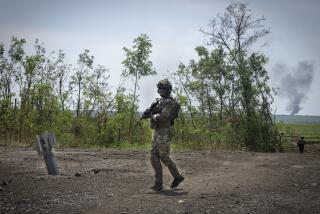U.S. ‘Phantom Brigade’ Spearheads Drive : Offensive: 3rd Infantry unit met little opposition but mass surrenders slowed its assault.
- Share via
NEAR AL BUSSAIYA, Iraq — This 1st Armored Division is part of the massive American armored force that roared nearly 100 miles into Iraq, virtually unopposed, across miles of empty desert in an overland assault slowed only by need to round up the Iraqi troops who surrendered in its path.
The division closed in on this crossroads town on Monday after a 26-hour charge across Iraq that saw its tanks and armored vehicles stretched out in a flying wedge battle-formation across miles of enemy territory.
To each side was another Army division, with cavalry units to the north, on a rumbling charge that created a dust storm of its own as the armor headed northward.
But the attack slowed significantly as this lead brigade--known as the ‘phantom brigade’--confronted enemy positions that provided almost no opposition but offered up mass surrenders by Iraqis who took much of the afternoon to be rounded up.
“You’ve been victimized by success,” the division commander, Maj. Gen. Ronald H. Griffith, assured his subordinates by radio. But the slowdown wasfrustrating to American commanders whose prisoner collection resources were quickly overwhelmed.
There were reports elsewhere in the division of resistance that led to skirmishes against Iraqi forces. But this lead brigade faced no enemy fire in continuing a northward charge that began Sunday afternoon and did not find a need to lock-and-load its weapons until more than 50 miles inside Iraq.
In its only engagement until the artillery bombardment Monday night, the brigade opened fire with artillery, mortar and tanks at an Iraqi training camp believed to shelter a small resistance force.
But the facility had been deserted, as its defenders fled into the desert and then turned themselves over to U.S. troops. By nightfall, the brigade had taken nearly 400 prisoners, about half believed to have come from the compound.
The brigade had launched into Iraq at 4:30 p.m. Sunday, roaring through pre-exploded holes in an Iraqi border berm in a wide-flank armored attack in which commanders were so confident of encountering no immediate opposition that all headed into battle with hatches open to the sky.
The unit, attached here from the 3rd Infantry Division, served as the advance guard for the 1st Armored Division in the centerpiece of the VII Corps attack.
The massive Army overland assault, from a position well to the west of Kuwait, was launched about 12 hours after the U.S. ground offensive began, in what was to be the main American strike force in a bid to penetrate deep within Iraq.
“The soldiers know this is the way home,” said Maj. Roy Adams, the brigade operations officer, as thousands of tanks, armored personnel carriers and other vehicles began to head north in a battle formation that stretched across the horizon. “And it’s the right thing to do.”
Soldiers wore chemical protective suits and had taken pills designed to ward off the effects of nerve gas. But with intelligence reports showing no enemy forces immediately in front of the Army forces, the probe across the eight-foot tall, double-walled border berm was launched with little apprehension.
Instead, commanders have long focused their attention on what they would encounter after reaching this northern city, not far from the positions where Republican Guard divisions has established set defenses.
The initial attack came on a gusty, gritty day that turned the desert dusky with blowing sand; most helicopters were grounded, and tanks rumbled in vast formations across the desert with no forward guard.
But Griffith, the division commander, hovered at the border to watch as the division’s hundreds of tanks and armored vehicles crossed into Iraq.
A gunner held up a sign that said “Welcome to Iraq,” and the brigade commander, Col. James Riley, came on radio to remind his men--attached to this division--that they were about to qualify for the combat duty patch that soldiers wear on their right side.
“When we cross that line,” he said, “shift that Marne (3rd Infantry) patch from the left side of your helmet to the right, because that’s where it will belong.”
The division met no enemy resistance in its first hours of battle, and suffered its only casualties in a minor auto accident and the explosion of a dud artillery shell that left three soldiers wounded.
Indeed, despite concerns about enemy minefields, the principal threat to the U.S. advance in those first hours of the attack came from unexploded ordnance, believed to have been left over from an earlier U.S. bombardment.
Some units had to pick their way through areas where bombs and shells lay scattered on the ground; later, terrain that proved unexpectedly difficult to negotiate also slowed the Army advance.
The absence of opposition, at least in the initial forward surge, came as a relief to officers here whose units had begun to spot Iraqi drones flying over U.S. positions south of the border in surveillance missions some feared would cause Iraq to shore up its defenses.
Instead, as the division charged its first 30 miles into Iraq, its forward elements found terrain as barren as that of northern Saudi Arabia, with only rusty oil drums and the remains of observation posts to suggest that Iraq had ever maintained a military presence.
More to Read
Sign up for Essential California
The most important California stories and recommendations in your inbox every morning.
You may occasionally receive promotional content from the Los Angeles Times.












